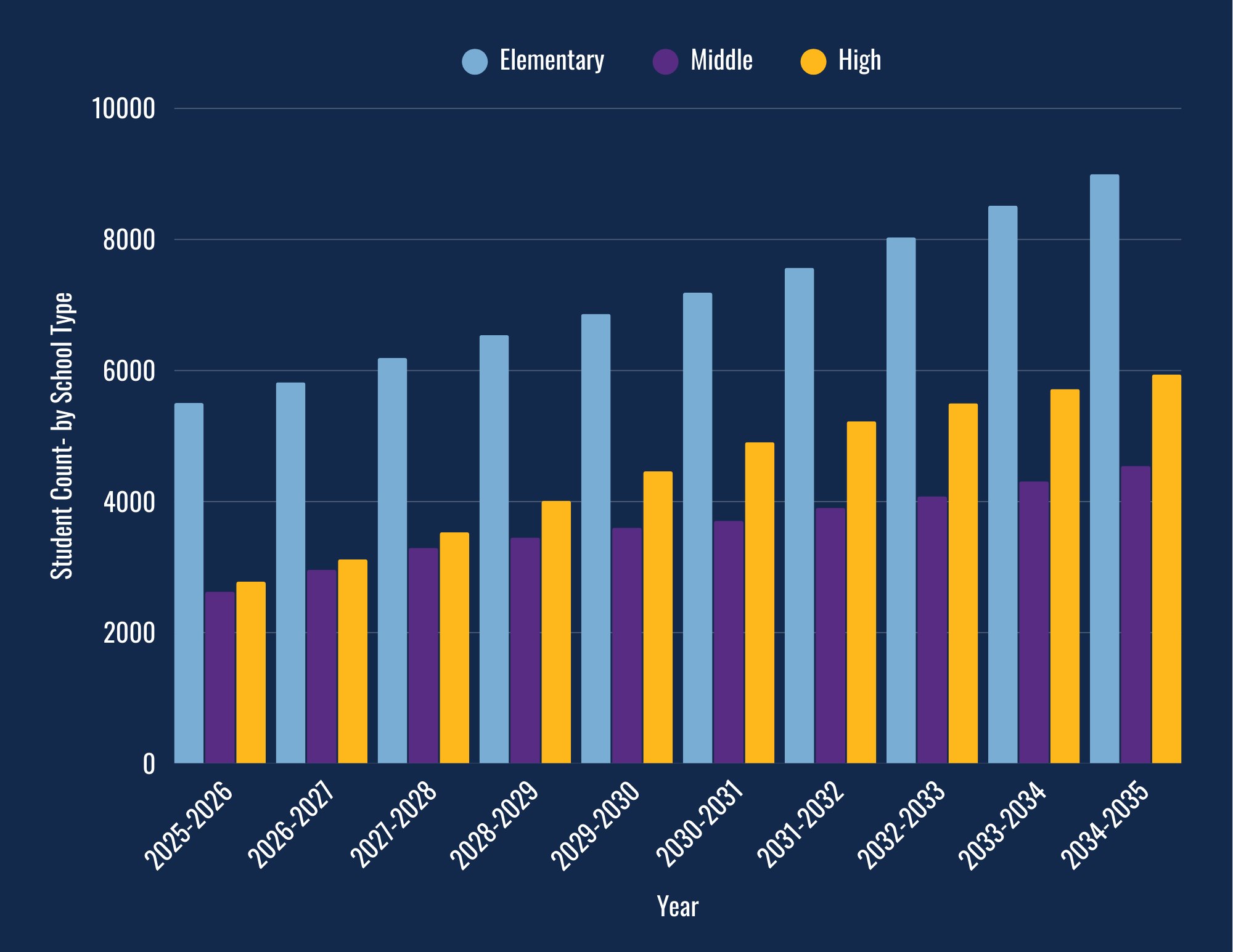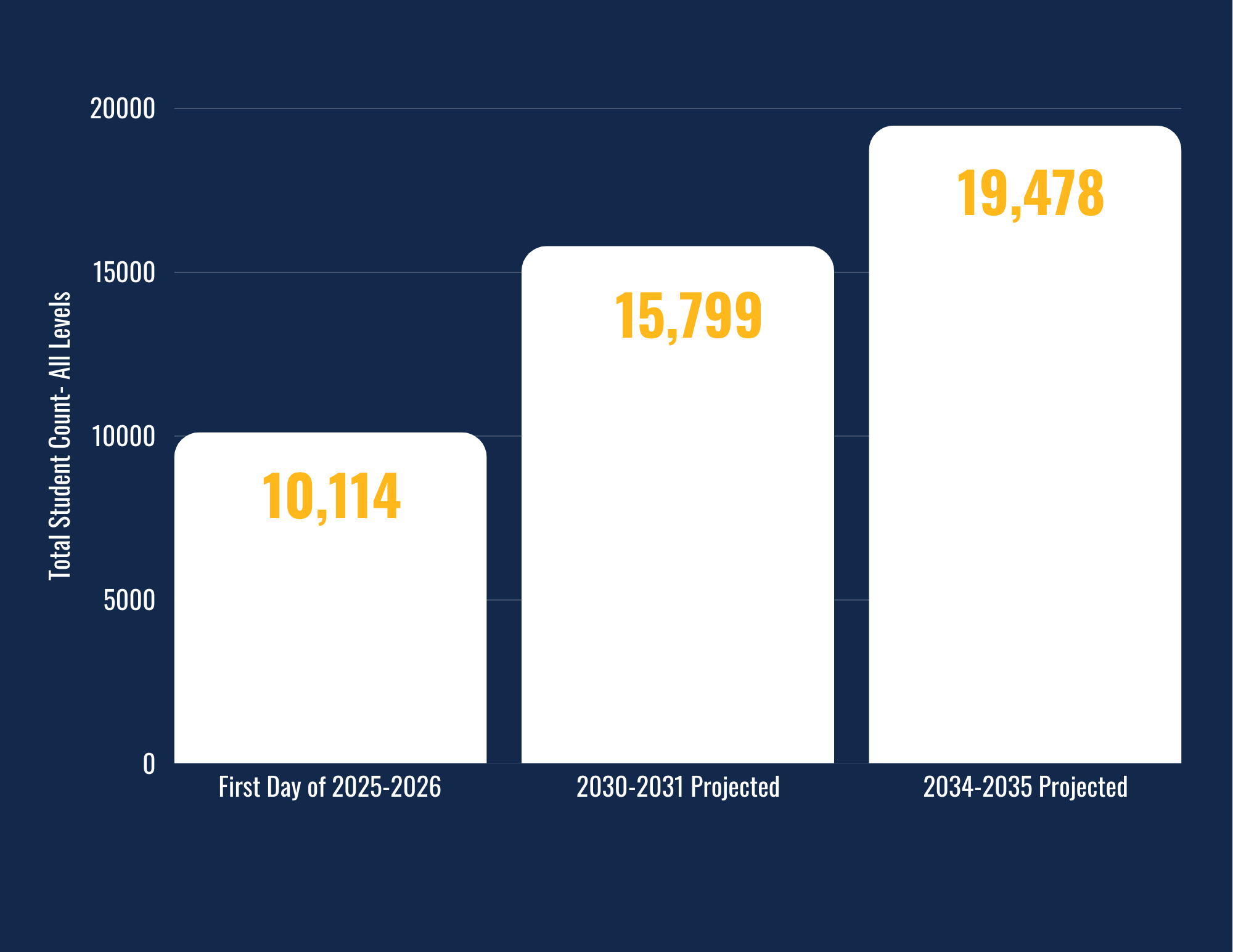Frequently Asked Questions
Bond FAQs
-
Just as homeowners borrow money in the form of a mortgage to finance the purchase of a home, a school district borrows money in the form of bonds to finance construction, renovation and other capital projects. Both are repaid over time, but in order for a school district to sell tax supported bonds, it must go to the voters for approval.
A voter-approved school bond allows a school district to borrow funds to finance capital projects. The Board of Trustees authorizes bond elections, and State law grants the Board the authority to sell bonds.
-
Bond funds can be used to pay for new buildings, additions and renovations to existing buildings, land acquisition, technology, buses, and equipment, among other items. By law, bond funds may not be used to fund daily operating expenses, such as salaries or utilities, which are paid for out of the district’s Maintenance & Operation (M&O) budget.
-
School districts are required by law to ask voters for permission to issue bonds in order to pay for capital expenditures for projects like building a new school or making renovations to existing facilities. Districts take out a loan and then pay that loan back over an extended period of time, much like a family takes out a mortgage loan for their house.
-
The Liberty Hill ISD Long-Range Planning Committee comprised of parents, teachers, campus administrators, and community members meet over the course of several months to study district needs at all grade levels and campuses and discuss the future vision for Liberty Hill ISD students. The group studies campus safety, a district-wide facilities assessment, demographic projections, school capacity and enrollment, school finance, and other data and make their recommendation on Bond needs to the Liberty Hill ISD Board of Trustees for consideration.
-
100% of the bond package will go toward managing our fast growth, preparing for current and future students, and maintaining existing schools.
-
No. The district will only issue bonds to cover the cost of projects at the time they are needed and approved by the School Board.
Growth FAQs
-
Liberty Hill is one of the fastest growing school districts in Texas. Families are attracted to our district because of our commitment to academic excellence and our award-winning athletic and fine arts programs.
The district is projected to enroll around 13,000 students by 2027 and close to 20,000 students by 2035.
Over the last five years, new home sales in Liberty Hill have increased significantly, making LHISD a fast-growth district.
While Region 13 (Central Texas including LHISD) has only grown 2% since 2019, Liberty Hill ISD has grown by 101%.
Tax FAQs
-
The bond package will NOT increase the property tax rate for Liberty Hill ISD homeowners or businesses.
LHISD’s I&S tax rate is capped at $0.50 and, by law, cannot be increased. If this bond package is approved by voters, the district’s tax rate will not increase. The district can make all existing and new bond payments with the current school district tax rate.
-
The bond package will NOT increase the property tax rate for Liberty Hill ISD homeowners or businesses.
LHISD’s I&S tax rate is capped at $0.50 and, by law, cannot be increased.
Homeowners 65 years of age should have their senior citizen homestead exemption filed to avoid an increase in taxes in other school funding elections.
-
Your Liberty Hill ISD school taxes are based upon the value of your property as set by the Williamson Central Appraisal District. They set the value of your home on which the taxes are based.
Voting FAQs
-
There is no Liberty Hill ISD Bond in the upcoming November 2025 election. To learn more about the Tax Ratification election, visit www.LHvotes.com
Registered voters can vote at any location in Williamson County. Your ballot will include all of the items you are eligible to vote on based on your location. For example, if it is easier to go to a poll in Cedar Park near your office, your ballot will still include Liberty Hill items for your consideration.
-
Anyone who is a registered voter and lives within the Liberty Hill ISD district boundaries is eligible to vote in this election.
Visit the Williamson County election plage to learn more here.
-
To see if you’re registered, visit My Voting portal here.
-
You can learn more and register to vote here.
Understanding
Tax and Financial Information
-
Public school taxes involve two figures which divide the school district’s budget into two “buckets.”
The first is the Maintenance & Operations (M&O) budget, also known as the General Fund. This is used to pay for the day-to-day operations of a district and includes items such as salaries, utilities, food, gas, supplies, etc.
The second is the Interest & Sinking (I&S) budget or Debt Service. This fund is used to repay debt for capital improvements approved by voters through bond elections. This fund is similar to a mortgage or home improvement loan.
Funds from a bond issue can be used for the construction and renovation of facilities, the acquisition of land, and the purchase of capital items, such as equipment, technology, and transportation. By law, I&S funds cannot be used for the M&O budget, which means voter-approved bonds cannot be used to increase salaries or to pay for rising costs of utilities or services.
Learn more on our budget basics page here.
-
For residents 65 years and older, their school district tax bill will not increase, even if their property values increase (excluding new property improvements) as long as an approved Homestead and Over-65 Exemption application is on file with the Williamson Central Appraisal District, and the property has been owned as of Jan. 1 of the tax year.
For more information about Homestead and Over-65 Exemptions, click here.
Understanding School Bonds in Texas
-
A school district’s tax rate consists of two parts:
Maintenance and Operations (M&O) which funds the General Operating Fund, which pays for salaries, supplies, utilities, insurance, equipment, and the other costs of day-to-day operations; and
Debt Service (Interest & Sinking or I&S) can be used for a variety of special purposes, assuming voter approval. For example, they may finance facility construction and renovation projects, acquire land, or purchase capital equipment, such as technology, and transportation, such as buses.
-
From school bonds. Likened to a home mortgage, a voter-approved school bond allows a school district to borrow funds. The Board of Trustees authorizes bond elections, and Texas law grants the Board the authority to sell bonds. Prior to any bond vote, a volunteer citizen committee is usually created to develop a bond package for presentation to the Board of Trustees. The Board approves the bond package – the specific uses of bond monies and the estimated costs for each project included in the bond.
After voter approval, the school district can sell bonds to investors who are repaid their principal plus interest. Payout is limited by law to 40 years. The district sells bonds that mature at different times, so bond expenditures for items with a shorter lifespan are paid off before the purchase becomes obsolete. This also allows the district to capture the lowest interest rates available.
Importantly, bonds do not cost the district anything until they are sold. A district receives a higher rating due to the guarantee by the Texas Permanent School fund, having a strong fund balance, and maintaining a record of financial management excellence. Of course, market conditions will affect the actual interest rates, which may be higher or lower than the original estimates.
-
As state agencies, school districts rely on M&O funds to pay for the day-to-day education of the district's children.
Bonds allow districts to spread the cost of expensive projects across time without affecting the district’s normal educational operations. Also, bond funds all stay with the district, and they are not subject to state recapture, fluctuations in revenue due to state mandates, or other negative economic influences.
In short, bonds save and protect taxpayers while allowing for essential, ongoing facility development and other capital expenses to be funded.
-
Voters approve a specific dollar amount— or the maximum amount the district is allowed to sell without another election. The school district may then sell their bonds as ‘municipal’ bonds when funds are needed for capital projects, usually once or twice a year.
The interest rate paid is based on the district’s bond rating and the interest rates in effect at the time of sale.
Districts benefit if they have a higher bond rating, meaning a lower interest could be charged. Principal and interest on the bonds are repaid over an extended period with funds from the Debt Service tax rate. (Source: TASB).
Thus, there are two parts to any bond process:
1) bond authorization that specifies the amount of bonds the district is authorized by the voters to sell, and
2) bond sales that may occur over a period of time with the date and amount of each sale determined by the Board on an as-needed basis. (TASB).
Note that a district is not obligated to spend all the authorized monies but cannot exceed the authorization.


